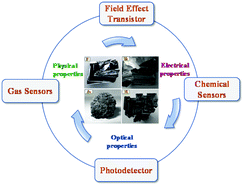Emerging pnictogen-based 2D semiconductors: sensing and electronic devices
Abstract
Pnictogens are an intensively studied group of monoelemental two-dimensional materials. This group of elements consists of phosphorus, arsenic, antimony, and bismuth. In this group, the elements adopt two different layered structural allotropes, orthorhombic structure with true van der Waals layered interactions and rhombohedral structure, where covalent interactions between layers are also present. The orthorhombic structure is well known for phosphorus and arsenic, and the rhombohedral structure is the most thermodynamically stable allotropic modification of arsenic, antimony, and bismuth. Due to the electronic structure of pnictogen layers and their semiconducting character, these materials have huge application potential for electronic devices such as transistors and sensors including photosensitive devices as well as gas and electrochemical sensors. While photodetection and gas sensing applications are often related to lithography processed materials, chemical sensing proceeds in a liquid environment (either aqueous or non-aqueous) and can be influenced by surface oxidation of these materials. In this review, we explore the current state of pnictogen applications in sensing and electronic devices including transistors, photodetectors, gas sensors, and chemical/electrochemical sensors.

- This article is part of the themed collection: Recent Review Articles


 Please wait while we load your content...
Please wait while we load your content...